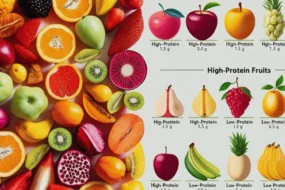
When choosing between organic and inorganic food, many wonder which option is healthier, safer, and more sustainable; organic food is grown without synthetic pesticides, chemical fertilizers, or GMOs.
In contrast, inorganic (conventional) food relies on these methods for mass production. But does organic food offer more nutritional benefits, or is it just a trend? How do pesticides in conventional food impact health?
This article breaks down the key differences between organic and non-organic food, covering nutritional value, environmental impact, cost, and health factors so you can decide what’s best for you.
Differences Between Organic and Inorganic Food
Organic food is grown without synthetic pesticides, GMOs, or chemical fertilizers, while inorganic food relies on them. Organic options focus on sustainability, whereas inorganic food is more affordable and widely available.
What Makes Organic Food Different?
Organic food is grown using natural farming practices without synthetic pesticides, artificial fertilizers, or GMOs. Farmers rely on organic methods like crop rotation, composting, and biological pest control to protect soil health and the environment.
To earn an organic label, food must meet strict certification standards, ensuring it’s free from harmful chemicals and growth hormones. Many health-conscious consumers prefer organic produce for its eco-friendly benefits, lower pesticide residues, and higher antioxidant levels.
Even though organic food costs more, it’s valued for its quality and sustainability. Superfoods like Microgreens are popular for their nutrient density and natural cultivation methods.
What Defines Inorganic (Conventional) Food?
Inorganic or conventional food is produced using synthetic pesticides, chemical fertilizers, and GMOs to boost crop yield and resist pests. Unlike organic farming, traditional methods rely on artificial growth enhancers, including hormones and antibiotics in animal products.
While non-organic food is more affordable and widely available, it may have pesticide residues and lower antioxidant levels. Many people choose inorganic options due to cost, but concerns about health risks drive interest in organic alternatives.
Some Foods For Picky Eaters include conventional fruits and vegetables, which are often preferred for their uniform appearance and sweeter taste.
Organic vs. Inorganic Food: A Side-by-Side Comparison
Here’s a clear comparison between organic food and inorganic (conventional) food to help you make an informed choice:
| Feature | Organic Food | Inorganic (Conventional) Food
|
| Farming Practices | Uses natural fertilizers, crop rotation, and composting | Relies on synthetic pesticides and fertilizers |
| Pesticides & Chemicals | Free from synthetic pesticides and GMOs | Contains pesticide residues and artificial additives |
| Nutritional Value | Often higher in antioxidants and natural nutrients | Nutrient levels are generally similar, but some studies debate differences |
| Health Impact | Lower pesticide exposure, may reduce health risks | Possible health risks from pesticides in conventional food |
| Environmental Impact | Promotes soil health, biodiversity, and sustainability | May contribute to soil degradation and water pollution |
| Cost & Accessibility | More expensive and less available | Affordable and widely available in supermarkets |
Choosing between organic vs. inorganic food depends on your health priorities, budget, and environmental concerns.
The Health Impact of Organic vs. Inorganic Food
One of the biggest concerns when choosing between organic and inorganic food is its impact on health.
Organic food is free from synthetic pesticides, growth hormones, and GMOs, reducing the risk of pesticide exposure and potential health issues. Organic produce contains higher antioxidant levels, which may help protect against diseases.
On the other hand, pesticides in conventional food can accumulate in the body over time, possibly increasing the risk of certain health conditions. While inorganic food is more affordable, many consumers opt for organic alternatives to minimize long-term health risks and eat more naturally grown produce.
Does Organic Food Have More Nutrients?
Many people believe organic food is more nutritious than conventional food, but is that true? Studies show that organic produce often has higher antioxidant levels, which may help fight disease.
Some research also suggests that organic farming improves soil quality, leading to higher vitamin and mineral content in foods like Spinach and Broccoli. However, the overall nutritional differences between organic and inorganic foods remain debated.
While organic food may offer slight benefits, organic and conventional options provide essential nutrients. Prioritizing fresh, unprocessed foods—organic or not—is key to maintaining a healthy diet.
Environmental Considerations
The environmental impact is a key factor when comparing organic vs. inorganic food. Organic farming promotes soil health, biodiversity, and sustainability by avoiding synthetic pesticides and chemical fertilizers. It also reduces water pollution and supports natural ecosystems.
In contrast, conventional farming relies on chemical pesticides and GMOs, which can contribute to soil degradation, loss of biodiversity, and water contamination.
While inorganic food is produced in larger quantities, its long-term effects on the planet raise concerns. Choosing organic produce supports eco-friendly farming practices and helps protect the environment for future generations.
The Cost Factor: Is Organic Worth the Price?
One major difference between organic and inorganic food is the cost. Organic food is often more expensive because it requires natural farming practices, avoids synthetic pesticides, and follows strict organic certification standards.
Additionally, organic farming produces lower yields than conventional farming, making organic produce less available and pricier.
On the other hand, inorganic food is cheaper and widely available, making it a more budget-friendly option. However, many consumers are willing to pay more for organic fruits and vegetables due to concerns about pesticides in conventional food and potential health benefits.
If cost is a concern, buying organic selectively—such as focusing on the Dirty Dozen list—can help balance health, affordability, and nutrition.
Expert Opinions & Consumer Trends
Health experts and nutritionists often recommend organic food for its lower pesticide residues and potential nutritional benefits. Some studies suggest that organic produce has higher antioxidant levels. Still, others argue that the nutritional differences between organic and inorganic foods are minimal.
Consumer interest in organic fruits and vegetables has grown as people become more aware of pesticides in conventional food and their possible health effects.
Despite the higher cost of organic food, many buyers choose organic alternatives for their health benefits and environmental impact. As demand rises, organic farming continues to expand worldwide.
Conclusion
Deciding between organic and inorganic food depends on your health priorities, budget, and environmental concerns. Organic food offers lower pesticide residues, higher antioxidant levels, and supports sustainable farming, but it is often more expensive.
Inorganic food, however, is affordable and widely available, though it may contain synthetic pesticides and GMOs.
For a balanced approach, consider buying organic produce for foods with high pesticide exposure, like those on the Dirty Dozen list. Ultimately, eating a diet rich in fresh fruits and vegetables—whether organic or conventional—is the key to good health.
I’m Ayesha Zahid, a certified Nutritionist and Dietitian with over 3 years of hands-on experience helping individuals and families improve their health through nutrition.




